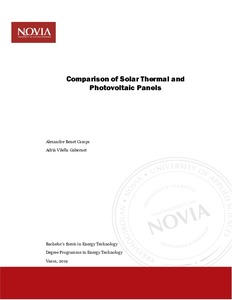Comparison of Solar Thermal and Photovoltaic Panels
Benet, Alexandre; Vilella, Adrià (2019)
Benet, Alexandre
Vilella, Adrià
2019
All rights reserved. This publication is copyrighted. You may download, display and print it for Your own personal use. Commercial use is prohibited.
Julkaisun pysyvä osoite on
https://urn.fi/URN:NBN:fi:amk-2019061316862
https://urn.fi/URN:NBN:fi:amk-2019061316862
Tiivistelmä
The aim of the thesis was to assemble and to make a comparison between a solar photovoltaic and a solar thermal panel installed system. The main differences related to the complexity of equipment needed for correct functionality of each system were documented and real–time measurement of the energy generated obtained.
The communication parameters for each device were gathered and tested using QModMaster software. With successful communication between devices established on the Modbus RTU network, a programme was designed, within LabVIEW software, to extract and store data from the sensors. Initial laboratory testing before formal roof installation demonstrated LabVIEW software to be successful in communicating with all the sensors using Modbus RTU.
For the roof mounted photovoltaic system, data for five consecutive days were obtained. These data demonstrated the difference in power output between a sunny and a partly cloudy day, as well as the relationship between the solar irradiation and the power generated. Estimation for the efficiencies was also calculated.
However, the complexity of installing the roof mounted solar thermal panel system, resulted in a lack of time to fully test the software simultaneously for both assembled systems.
The communication parameters for each device were gathered and tested using QModMaster software. With successful communication between devices established on the Modbus RTU network, a programme was designed, within LabVIEW software, to extract and store data from the sensors. Initial laboratory testing before formal roof installation demonstrated LabVIEW software to be successful in communicating with all the sensors using Modbus RTU.
For the roof mounted photovoltaic system, data for five consecutive days were obtained. These data demonstrated the difference in power output between a sunny and a partly cloudy day, as well as the relationship between the solar irradiation and the power generated. Estimation for the efficiencies was also calculated.
However, the complexity of installing the roof mounted solar thermal panel system, resulted in a lack of time to fully test the software simultaneously for both assembled systems.
